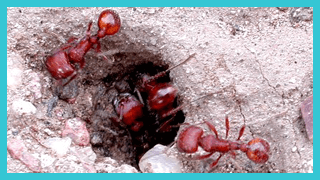Call for a Quick Estimate Today:
(702) 438-9708
 Common Name:
Common Name:
Harvester Ant
Scientific Name:
Pogonomyrmex species
Order and Family:
Formicidae, Ants
Pest Control Recommendation:
Ant Control & Extermination
Description:
Less than 1/16-1″ (1-15 mm) long, are mostly black, brown, or reddish.
Food:
Honeydew from aphids, nectar from flowers, and other insects.
Life Cycle:
Nests are often constructed close to small trees and shrubs. Entranceways are littered with pine needles, leaf fragments, and bits of stems. Queen tends 1st brood, then female workers care for eggs and young, feeding queen regurgitated food.
Habitat:
Ants live in colonies in underground tunnels or in galleries in deadwood.
Range:
Worldwide.
Discussion:
They have a complex social structure usually consisting of a wingless worker caste composed entirely of sterile females and a reproductive caste made up of winged, fertile males and females. But some species do not have a worker caste, and some reproductives do not have wings. Ants have a slender “waist,” or pedicel, of 1 or 2 beadlike or scalelike segments between the thorax and abdomen. They differ from wasps in having distinctly elbowed antennae. From time to time, winged males and females emerge from the nest and perform a brief mating flight. After mating, the males die, and the females lose their wings and return to the ground to start a new colony. Workers gather food, maintain and defend the nest, and tend eggs, larvae, and pupae.
WARNING: These ants are capable of delivering a sting that does not hurt at first, but can result in intense pain and swollen lymph nodes, particularly if the victim is attacked by a number of workers.


Professional, Commercial & Residential Pest Control
Pet & kid friendly, Safe, Organic, Natural Pest Control